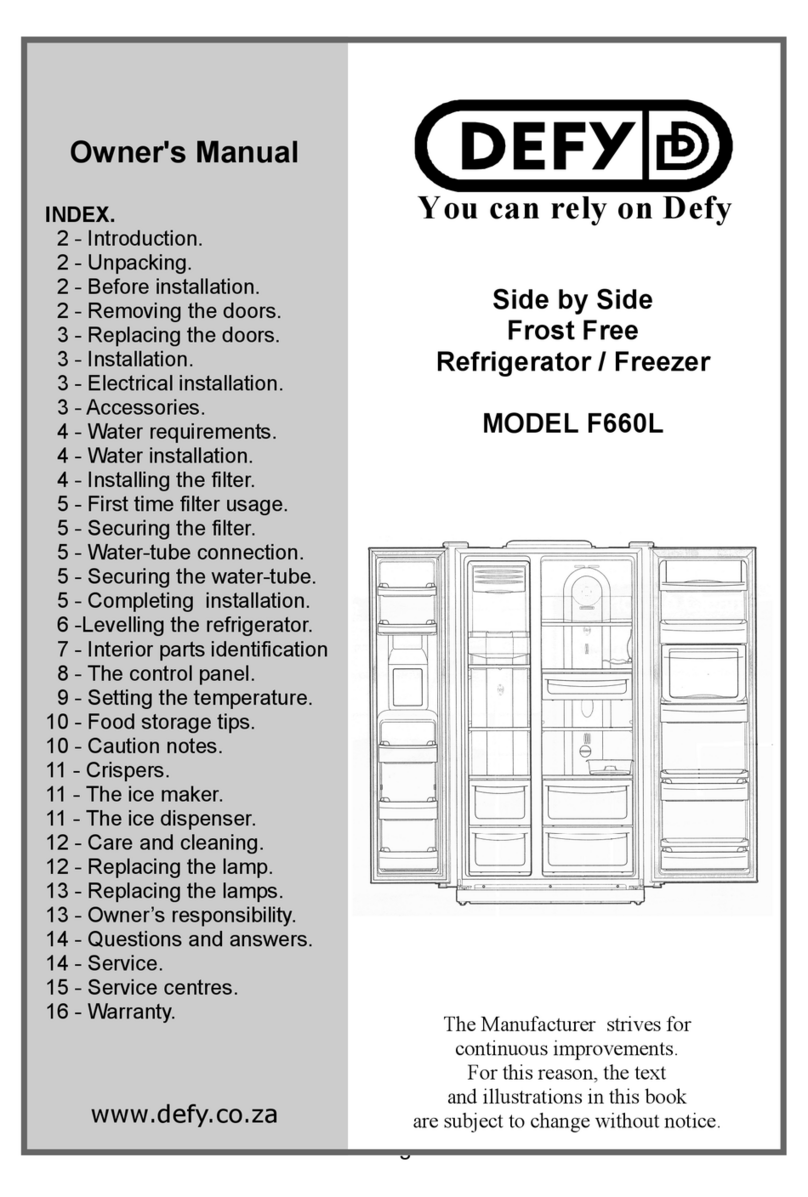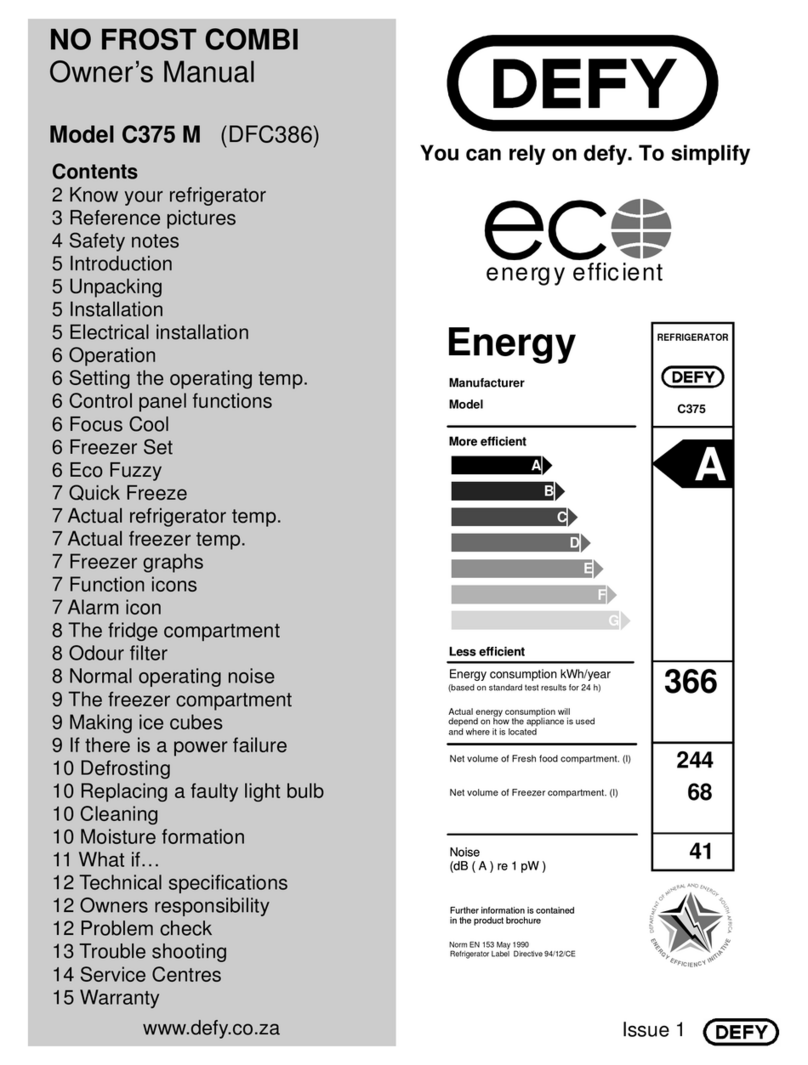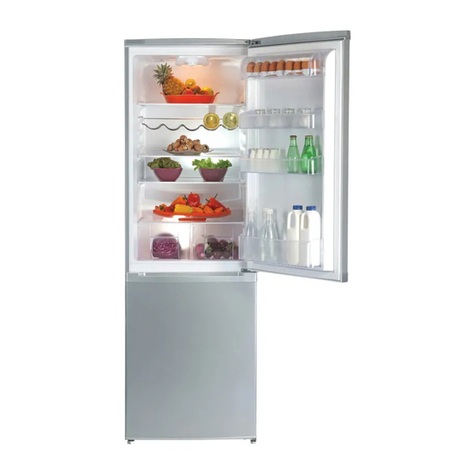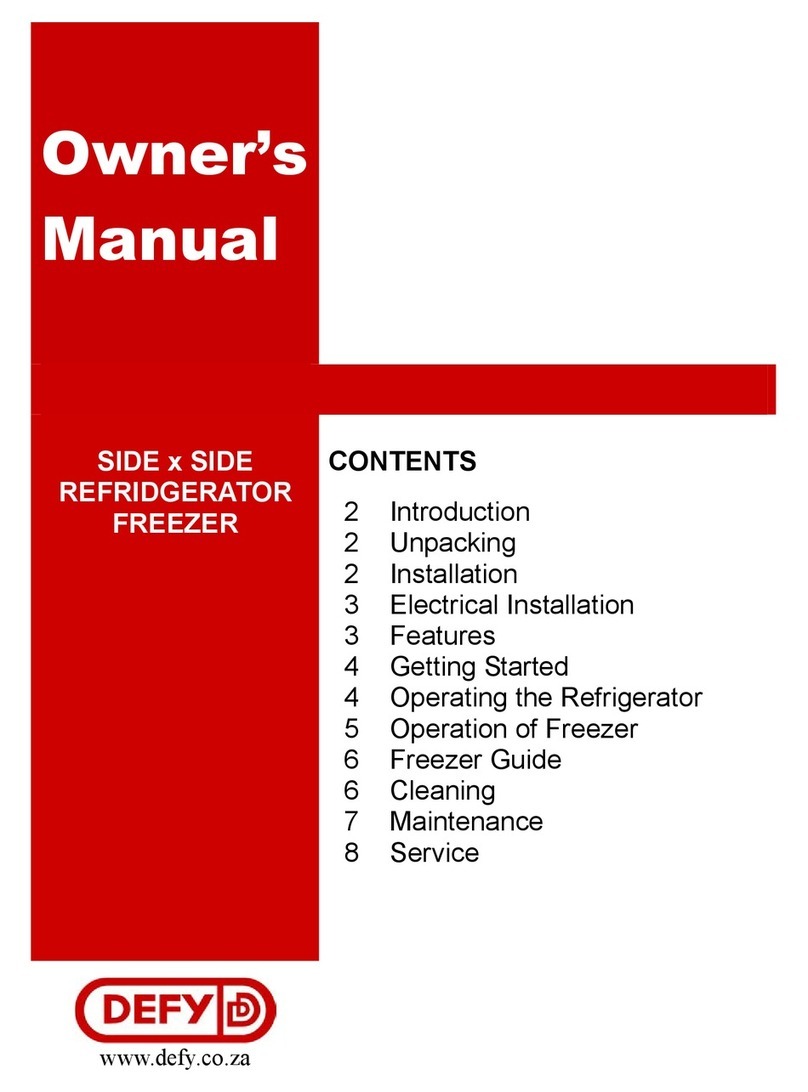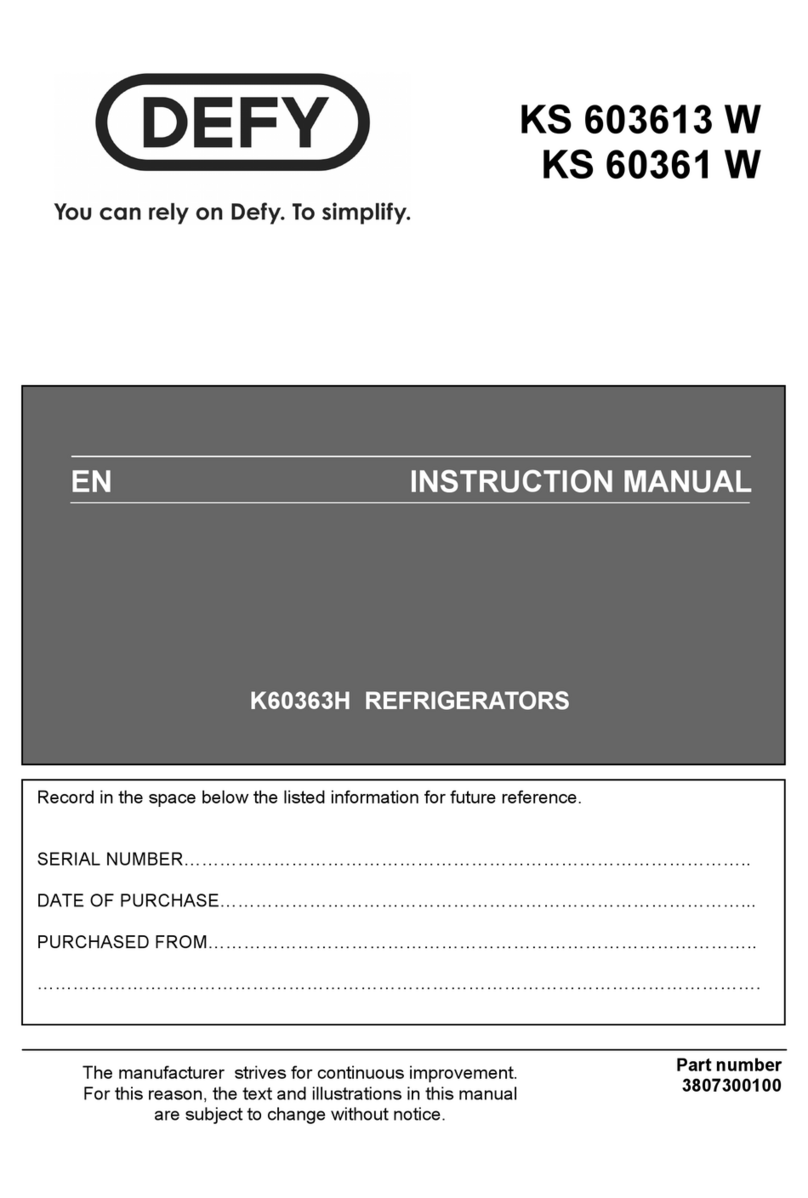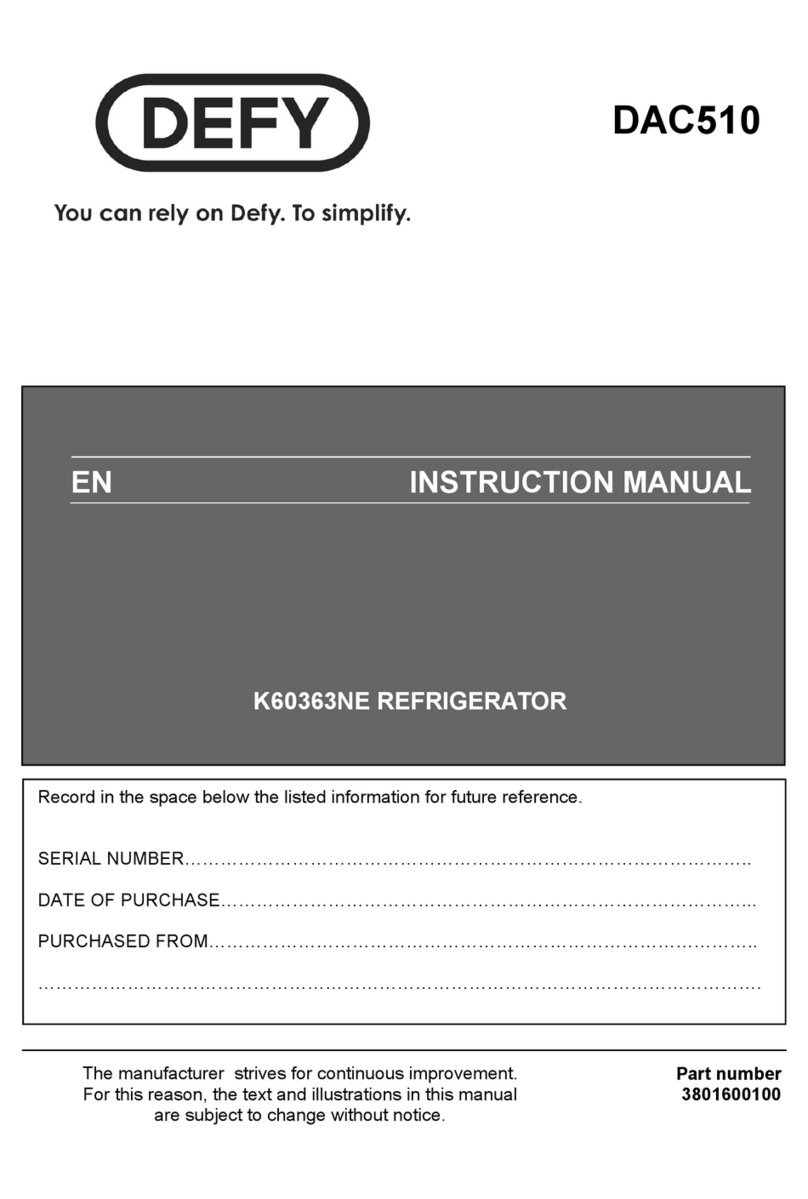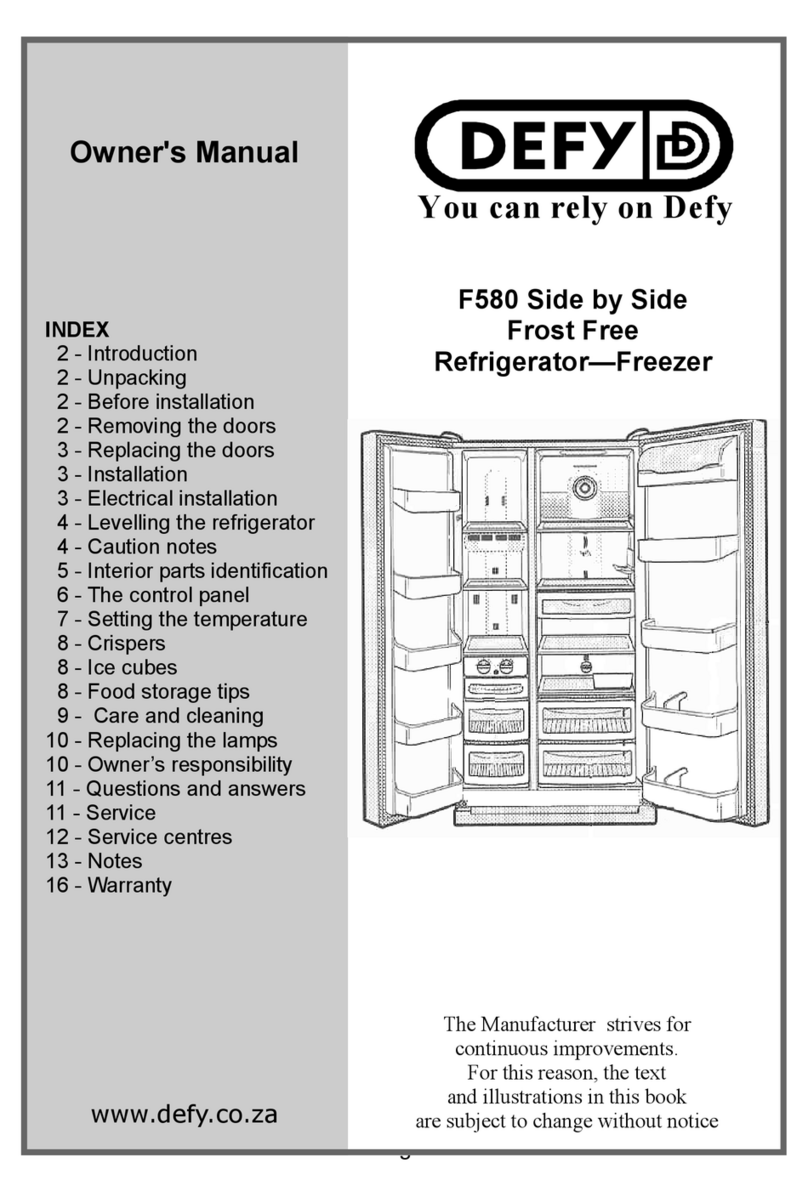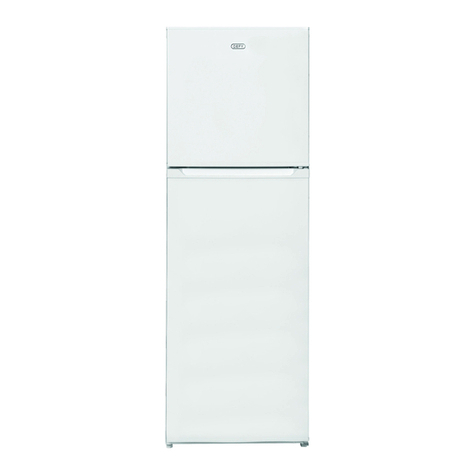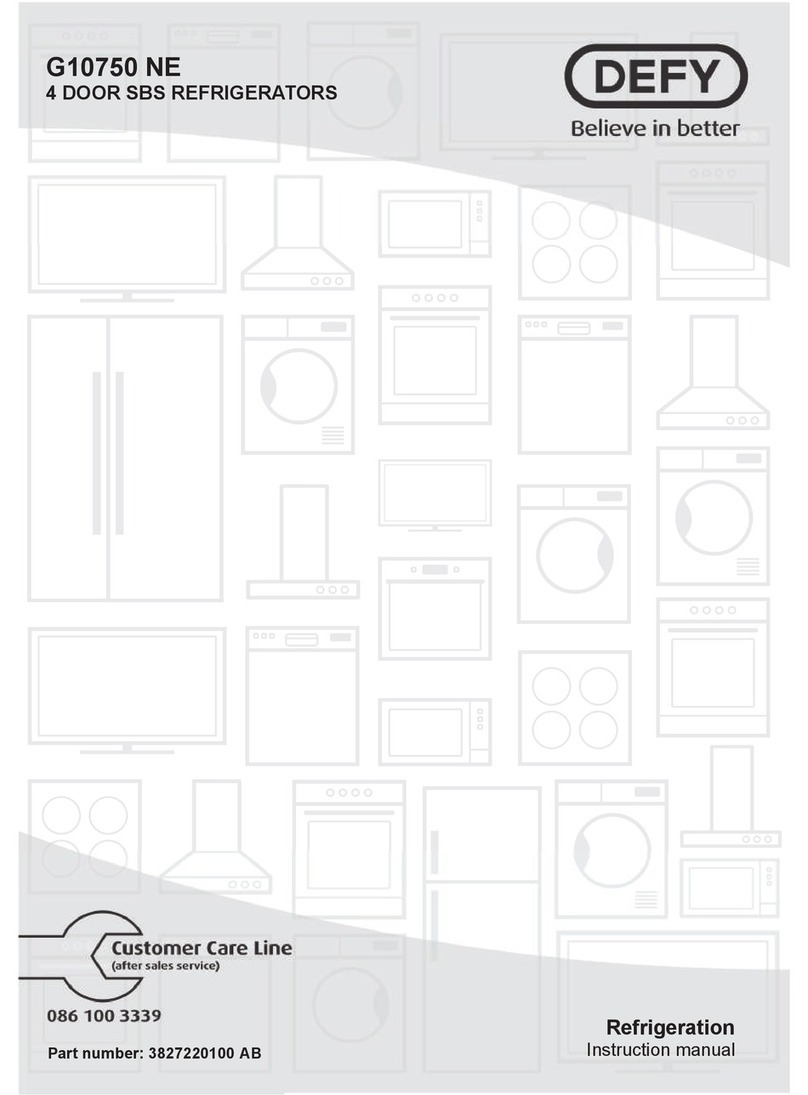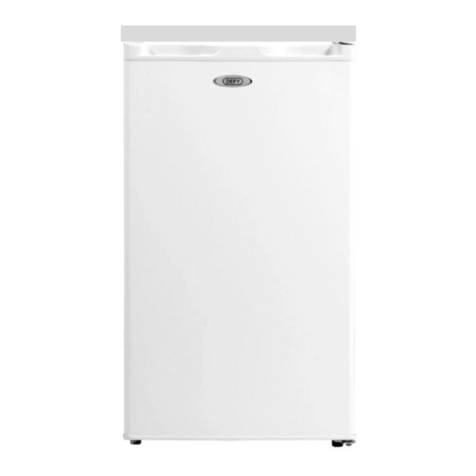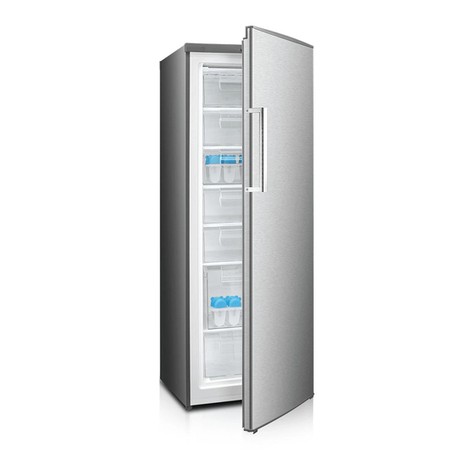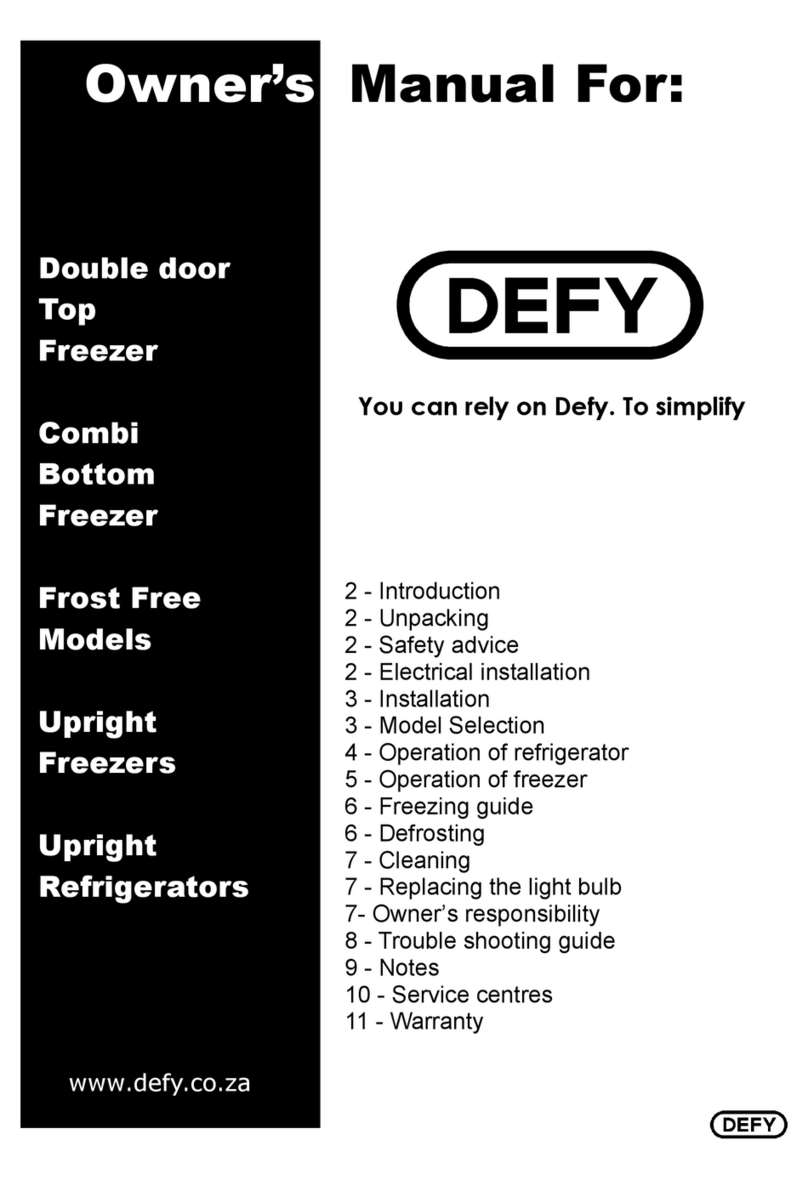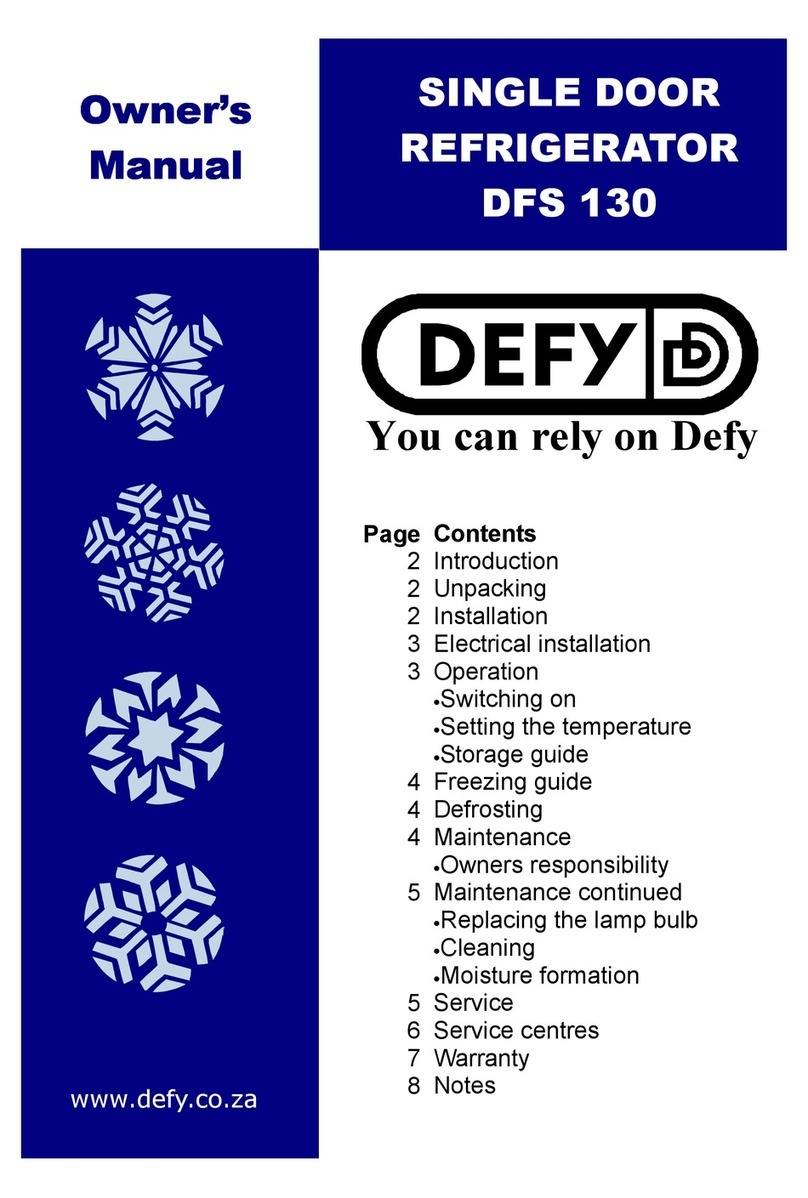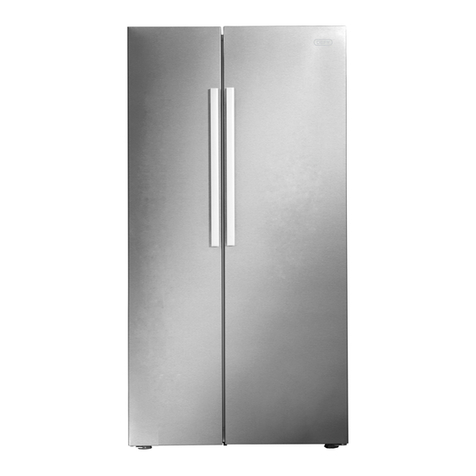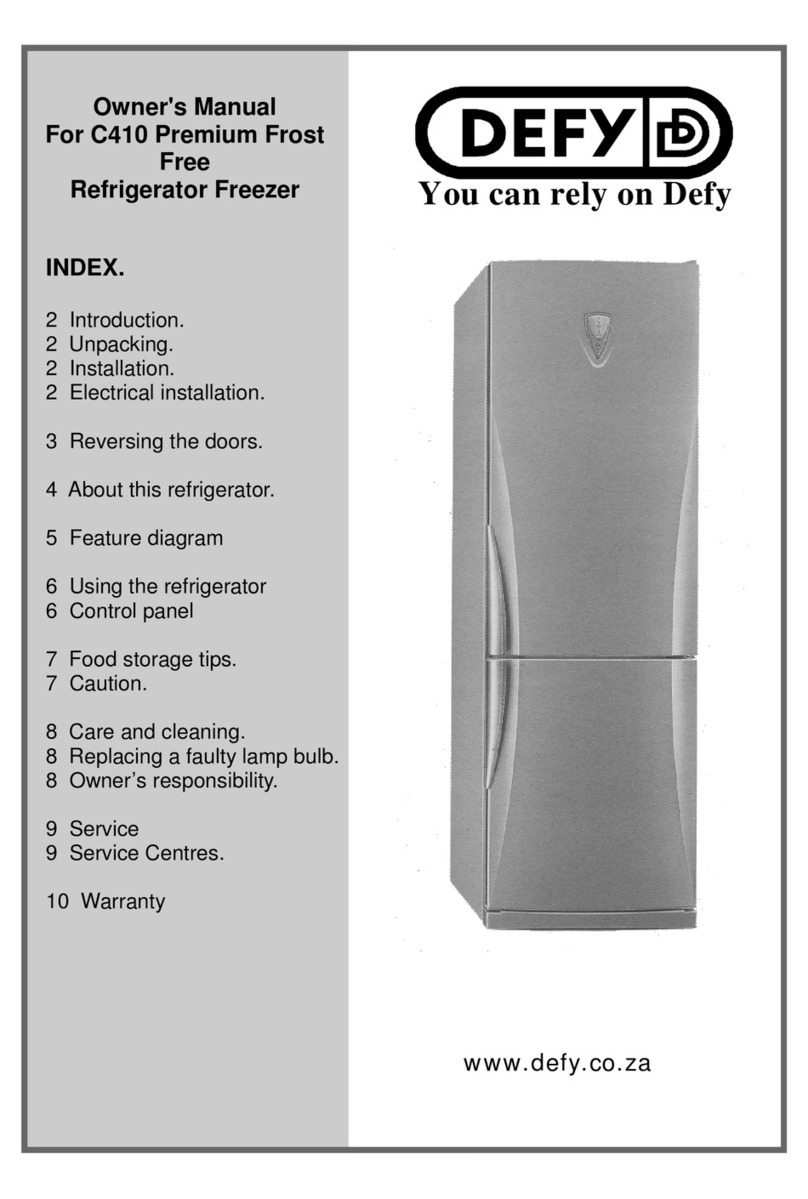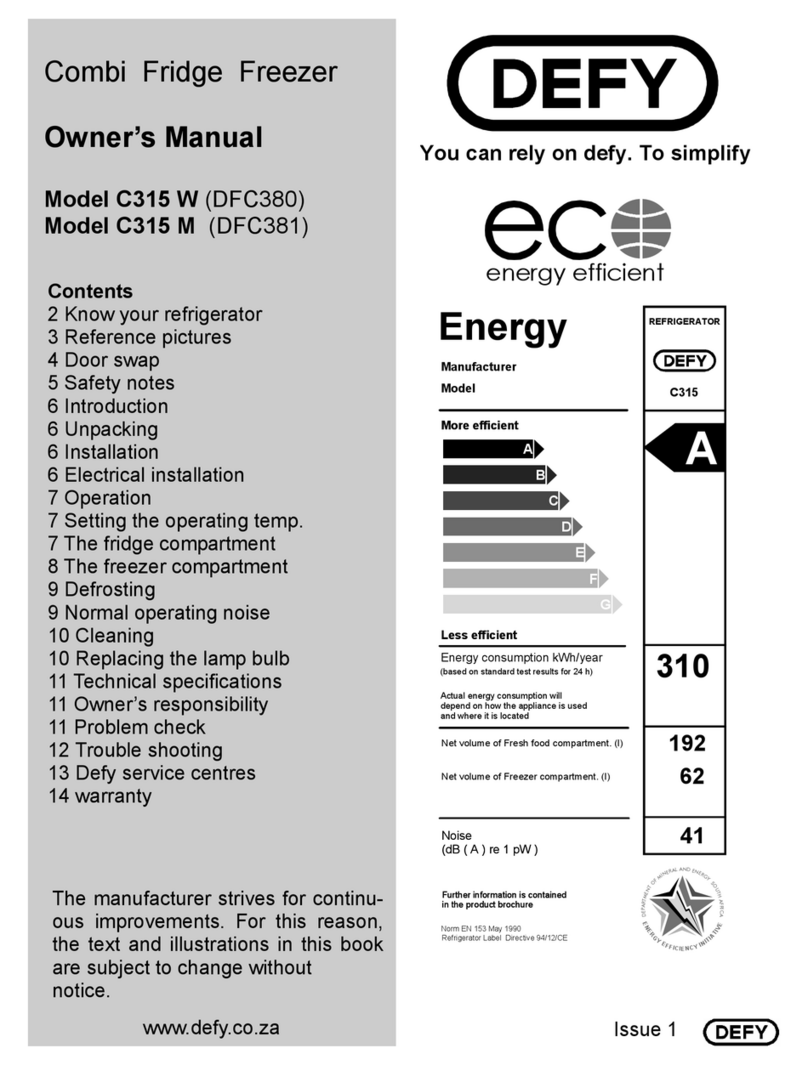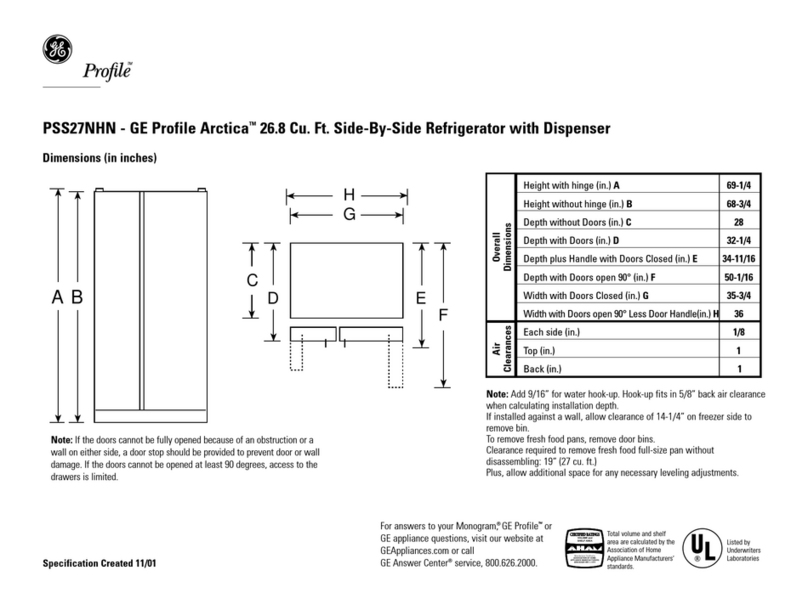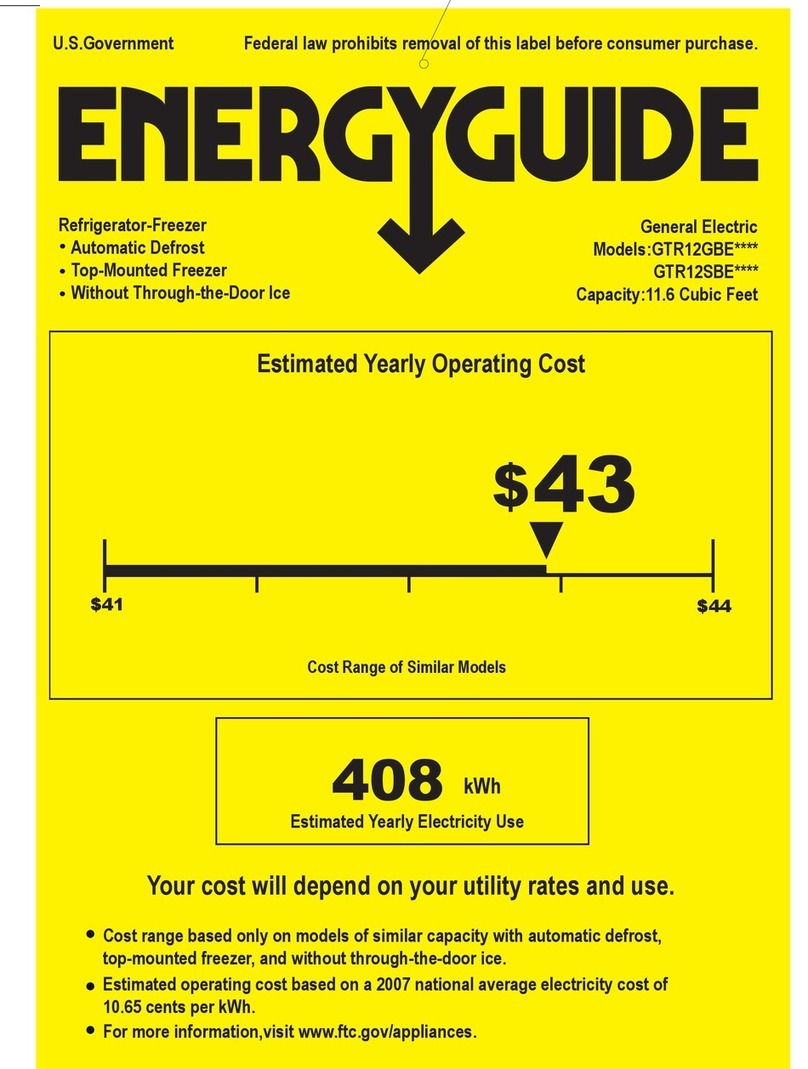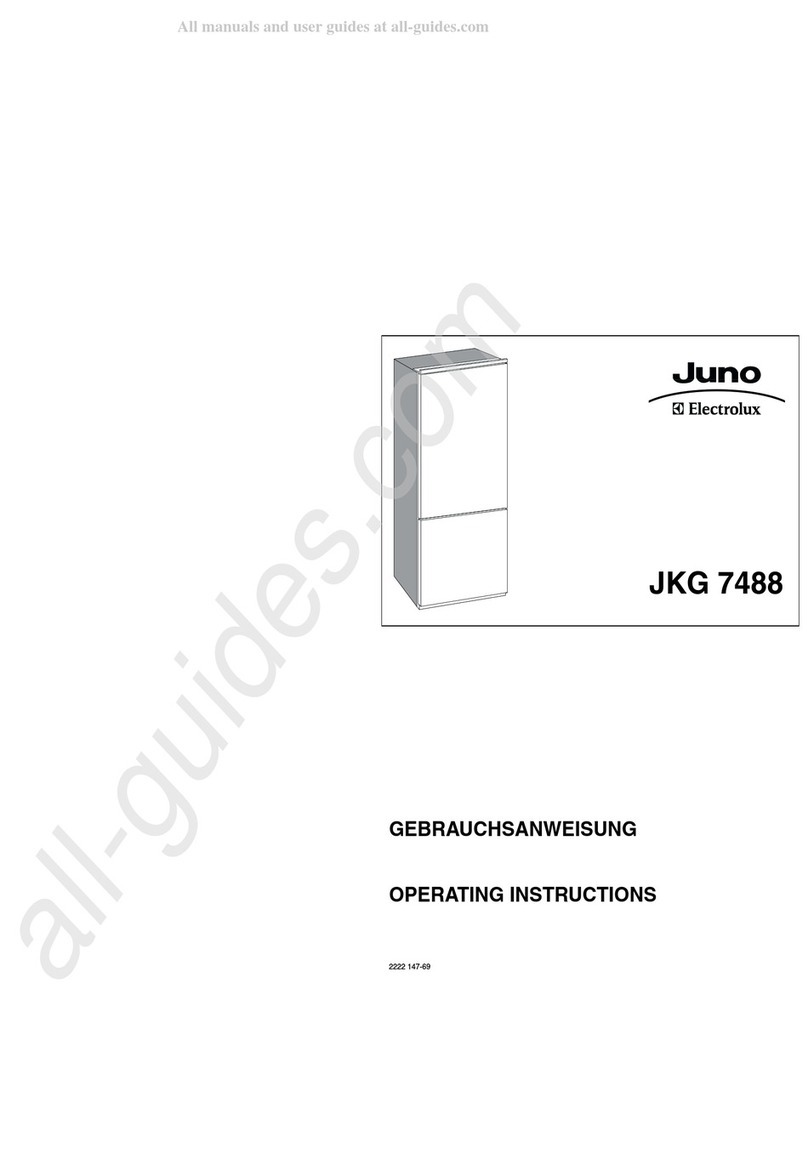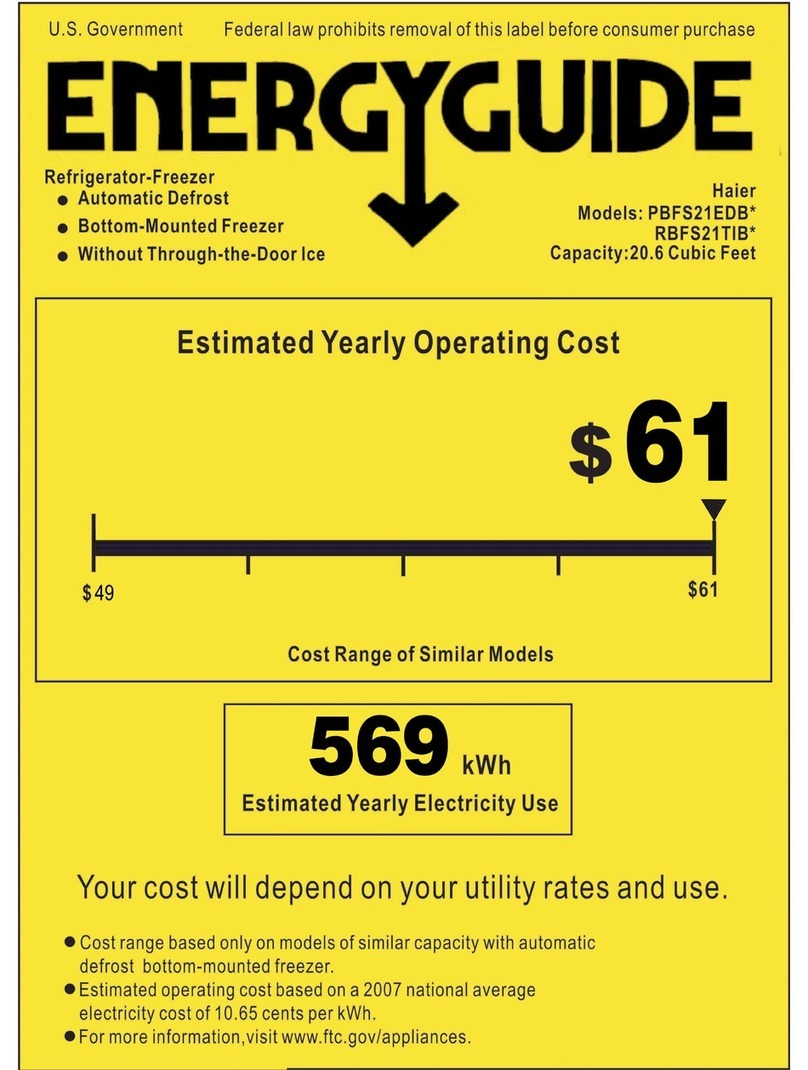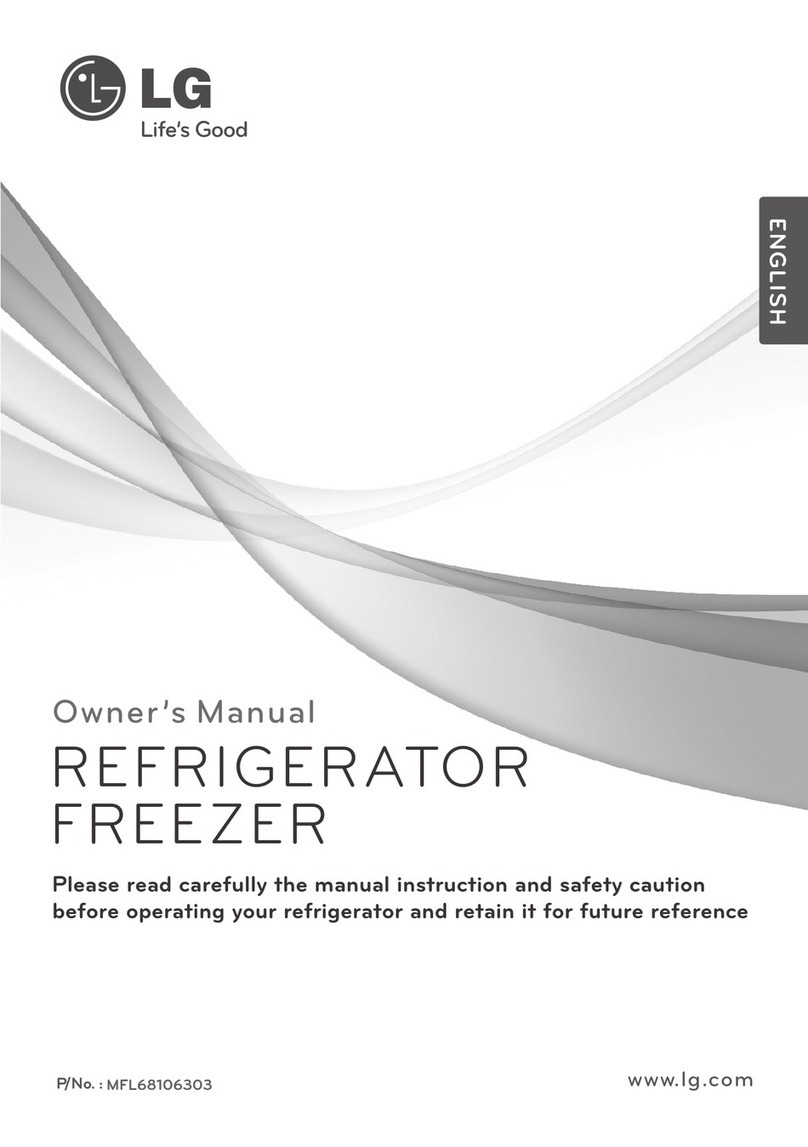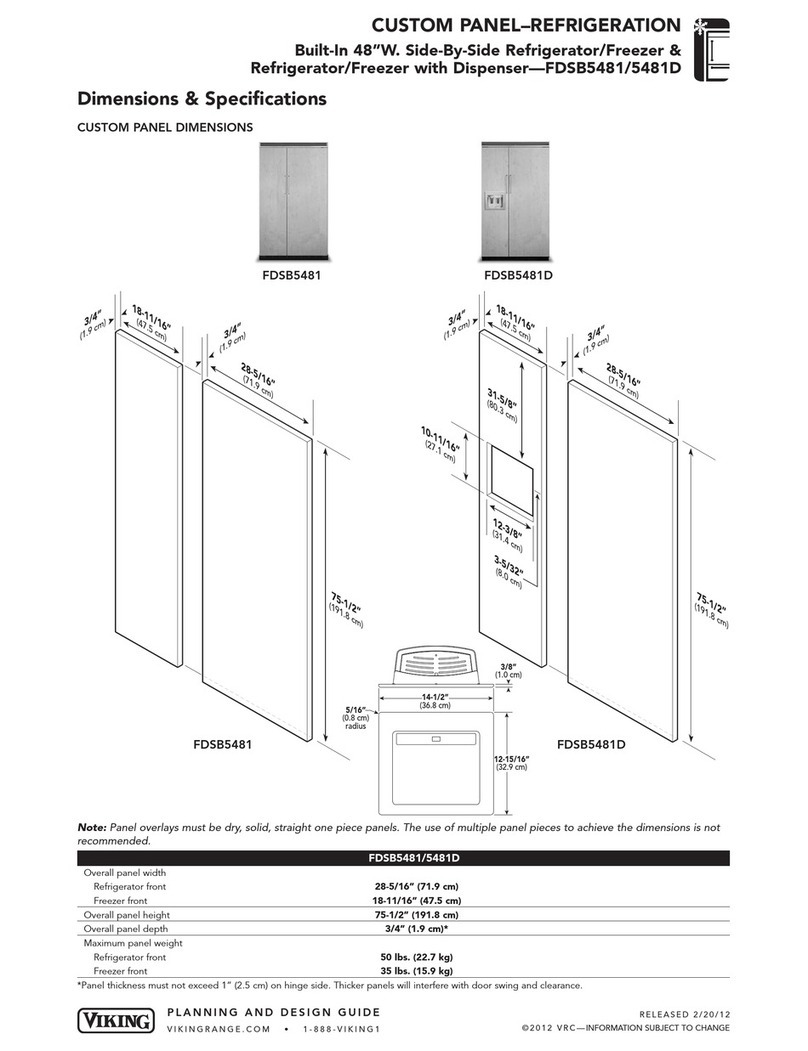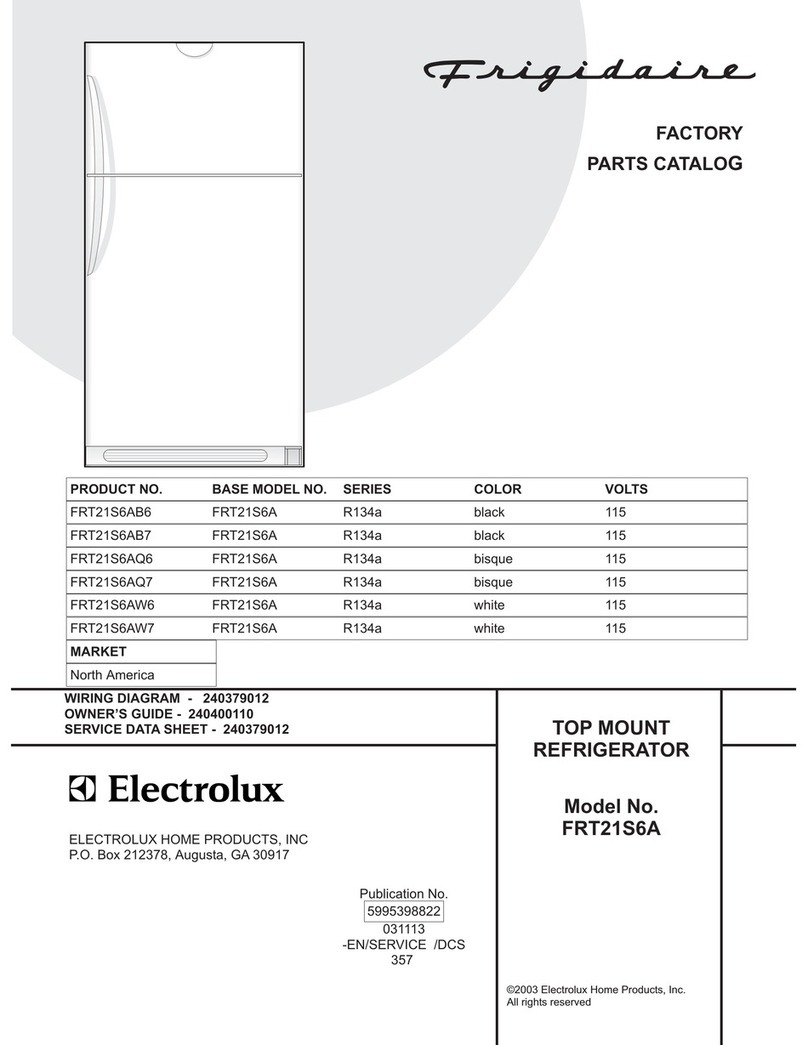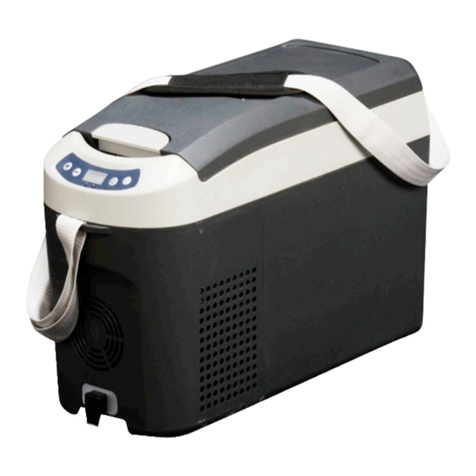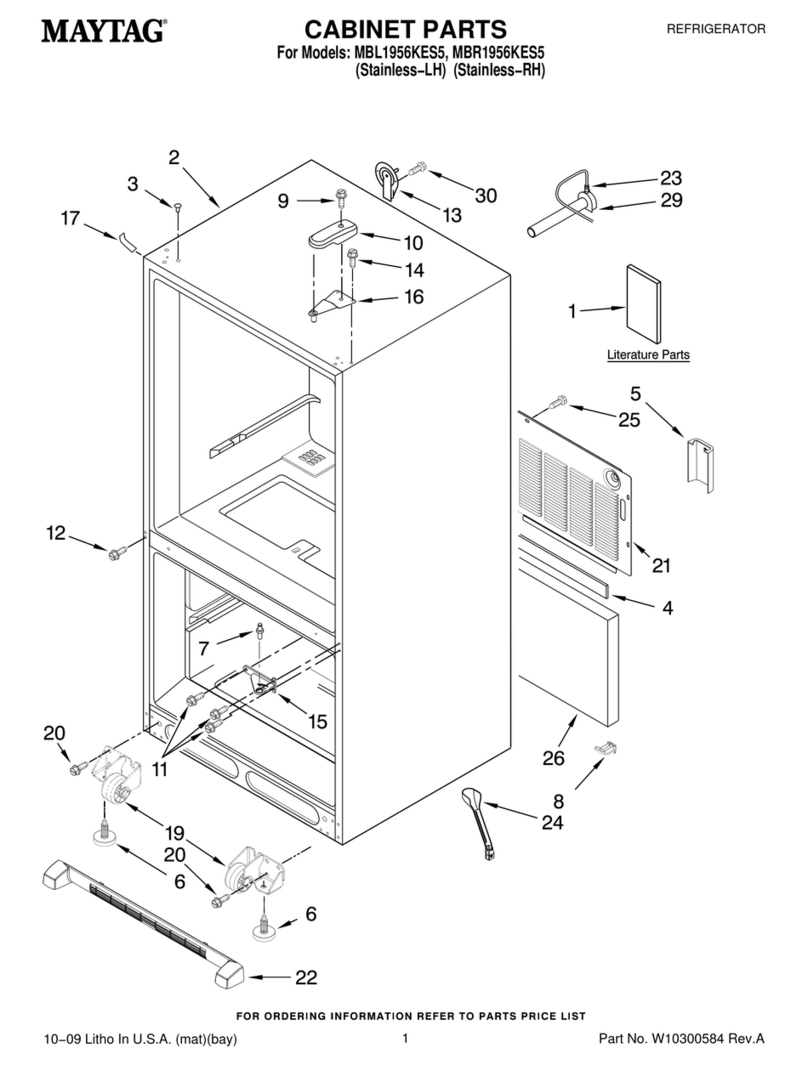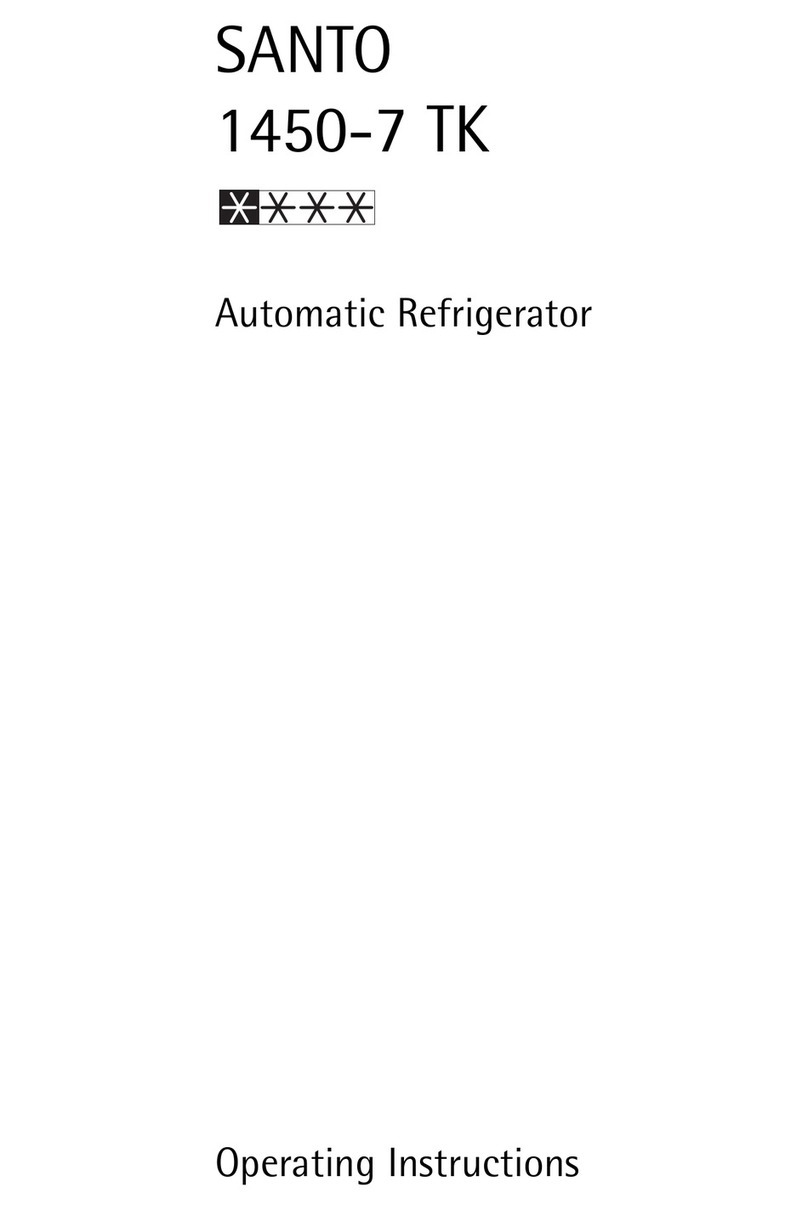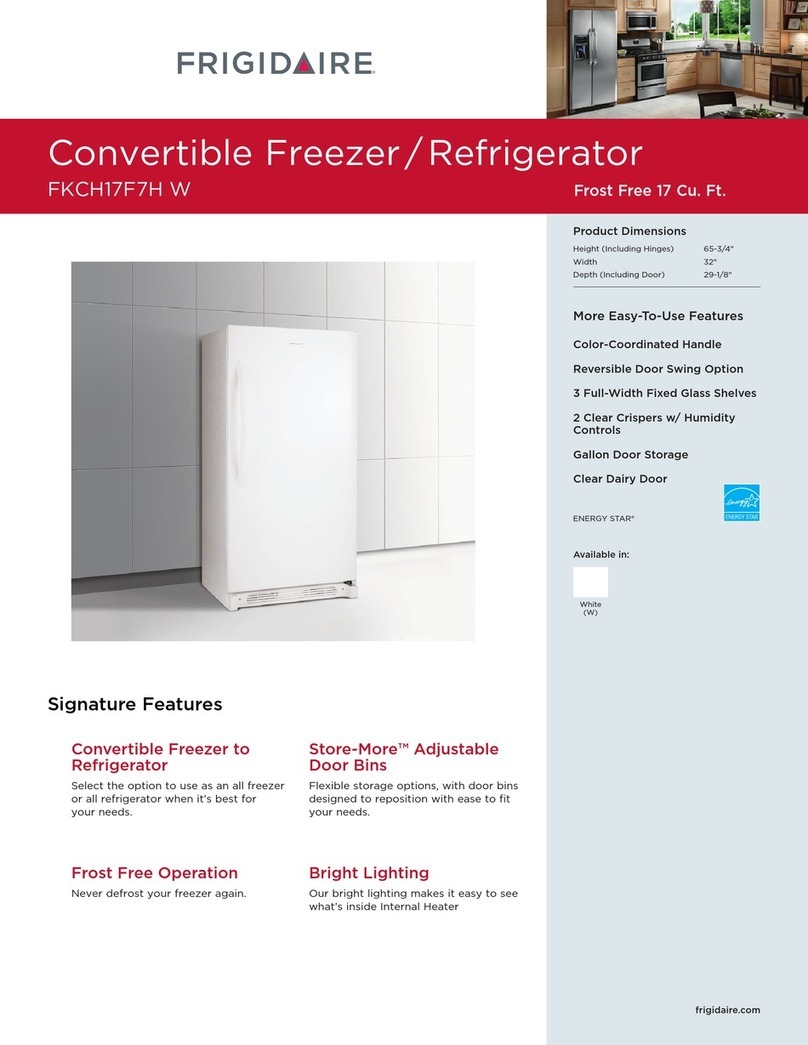Defy DAD 284 User manual

PAGE 1
The manufacturer strives for continuous improvement.
For this reason, the text and illustrations in this manual
are subject to change without notice.
Part number
2561505
ecord in the space below the listed information for future reference.
SE IAL NUMBE ..
DATE OF PU CHASE...
PU CHASED F OM..
.
INSTRUCTION MANUAL EN
Double door To Freezer
Combi Bottom Freezer
Frost Free Models
U right Freezers
U right Refrigerators

PAGE 2
Read this manual before initial installation and o eration of the
roduct!
Dear customer,
Your new Defy refrigerator was manufactured in a state of the art facility and has passed the
strictest quality control procedures.
Please read this manual carefully before using your product for the first time and then store it
within easy reach for future reference.
We trust you will enjoy years of trouble free use.
The user manual:
• This manual will provide you with information on how to safely operate and care for your
refrigerator in order that you gain the maximum benefit from it.
• Pay particular attention to any safety instructions.
• Please read all additional documents supplied with your refrigerator.
• Please note that this manual may be used for several similar but different models. Please
check for relevance regarding your particular model.
Ex lanation of symbols used in this manual
Important safety information. Warning for hazardous situations with regard to life and
property.
Caution; Warning for supply voltage.
Caution; Warning for fire hazard.
Caution; Warning for hot surfaces.
ead the instructions.
Useful information. Important information or useful hints about usage.
Un acking
emove all packaging. Ensure that packing material is disposed of in a responsible manner
and that any plastic bags are cut up to prevent children playing with them and accidentally
suffocating. If the refrigerator is damaged in any way do not use it. eport the damage to your
dealer who will take the necessary corrective action.
PLEASE EGISTE YOU P ODUCT AT
www.defy.co.za
DEFY APPLIANCES (PTY) LTD
P.O.BOX 12004
JACOBS
DU BAN
4026
SOUTH AF ICA

PAGE 3
Im ortant Safety Information 4
Warnings 4
Child safety 5
HCA Warning 5
Things to be done for energy saving 6
Installation 6
Points to be considered when
re-transporting your refrigerator 6
Before operating your refrigerator 6
Electrical connection 6
Adjusting the feet 7
Placing and installation 7
Model Selection 8
Operation of models 1,2 & 3 8
Operation of freezer model 4 9
Freezing guide models 2,3 & 4 10
Defrosting model 4 10
Defrosting models 1,2 & 3 10
Maintenance and cleaning 11
Trouble Shooting 12
Service Centres 14
Warranty 15
Contents
The manufacturer strives for continuous improvement. For this reason, technical
specifications, text and illustrations in this manual are subject to change without notice.
Figures in this manual are schematic and may not match your refrigerator exactly.
Values stated on the machine labels or in the documentation accompanying it are obtained
in laboratory conditions in accordance with the relevant standards. Depending on
operational and environmental conditions of the machine, these values may vary.

PAGE 4
is damaged. See HCA warning overleaf.
Do not damage the refrigerant circuit.
• Keep ventilation openings, in the
refrigerator or in the built-in structure, clear
of obstructions.
• Unplug the refrigerator when cleaning,
during routine maintenance or if it will not
be used for an extended period.
• To unplug the refrigerator, remove the plug
by pulling on the plug and not the cable!
• Exposing the refrigerator to rain, snow, sun
and wind is an electrical safety risk.
• Should the mains lead of the refrigerator
become damaged or should it need
replacing at any time, it must be replaced
by a special purpose made mains lead
which can only be obtained from a DEFY
Authorised Service Agent.
• Never connect your refrigerator to
electricity saving systems as they may
damage the refrigerator.
• Do not store medicine or academic
research samples which require strict
temperature control in the refrigerator.
• Do not store or use flammable gas,
benzene, petrol or volatile substances in or
near the refrigerator.
• Do not store explosive substances such as
aerosol cans with a flammable propellant
in the refrigerator.
• In the event of a malfunction, disconnect
the refrigerator from the power supply.
• Do not overload your refrigerator with
excessive amounts of food. If overloaded,
the food items may fall down and injure
you and damage the refrigerator when you
open the door. Never place objects on top
of the refrigerator, they may fall down and
injure you when you open or close the
refrigerator door.
Im ortant safety information
Please review and observe the following
information. Failure to do so may result in
injuries or material damage and will render
any warranty and reliability commitments
void. The usage life of the refrigerator you
have purchased is 10 years. This is the time
period that spare parts will be stocked for the
refrigerator to meet any maintenance or
service requirements.
This refrigerator is not intended for use by
persons (including children) with reduced
physical, sensory or mental capabilities or
lack of experience and knowledge, unless
they have been given supervision or
instruction concerning the use of the
refrigerator by a person responsible for their
safety. Children should be supervised to
ensure that they do not play with the
refrigerator.
Warnings
• Hand this owners manual over to the new
owner should ownership change.
• The refrigerator must only be used for its
intended purpose, i.e. the storing of edible
foodstuff.
• The refrigerator is intended to be used in
household and similar applications such as
staff kitchen areas in shops, offices and
other working environments; farm houses
and by clients in hotels, motels and other
residential type environments; bed and
breakfast type environments; catering and
similar non-retail applications.
• Consult with your authorised DEFY service
centre for all questions and problems
relating to the refrigerator. Only authorised
agents are to carry out repairs.
• Vapour and vaporized cleaning materials
must never be used in the cleaning and
defrosting the refrigerator. The vapour may
come into contact with the electrical parts
and cause a short circuit or electric shock.
• Do not allow children to hang on the
refrigerator door as the unit could topple
forward risking personal injury. Never use
the parts on your refrigerator, such as the
door, as a means of support or step.
• Do not use electrical appliances inside the
refrigerator or freezer.
• Do not drill, cut or modify the refrigerator.
Injuries may result if the refrigerant circuit
Do not operate a damaged
refrigerator. Consult with your
nearest DEFY service centre
should you have any concerns
The electrical safety of the
refrigerator is only guaranteed if
the earth system of your home is
compliant to national standards.
Never plug the refrigerator into
the wall socket during
installation. Death or serious
injury may result.

PAGE 5
Child safety
• If the door has a lock, the key should be
kept out of reach from children.
• If you are discarding an old refrigerator
with a lock or latch fitted to the door,
disable the lock/latch, and ensure that the
refrigerator is left in a safe condition to
prevent children from being trapped inside
and suffocating.
• Children must be supervised to prevent
them from tampering with the refrigerator.
HCA Warning
Refrigerator cooling systems containing
R600a:
efrigerators containing non CFC / HFC
natural substances in the cooling system
(Called 600a) and in the insulation (Called
cyclopentane). Please note that these
substances are potentially flammable if
exposed to fire.
Therefore, take care not to damage, the
cooling circuit / pipes of the refrigerator in
transportation and in use.
In case of damage do not ex ose the
refrigerator to fire or otential ignition
sources and immediately ventilate the
room where the refrigerator is situated.
Ignore this warning if your refrigerators
cooling system contains R134a.
• The refrigerator may move if the
adjustable legs are not properly levelled
on the floor. Levelling the adjustable legs
on the floor helps prevent the refrigerator
from moving.
• When carrying the refrigerator, do not hold
on the door handle as this may cause the
handle to break.
• When placing your refrigerator next to
another refrigerator or freezer, the
distance between the devices should be at
least 80 mm. Failure to do so may cause
adjacent walls to humidify.
• For refrigerators with a freezer
compartment; Do not put bottled and
canned liquid beverages in the freezer
compartment as they may burst.
• Do not touch frozen food with your hands;
they may stick to your hand.
• Never pour or spray water into or on the
refrigerator and do not store liquids, pot
plants or open containers on top of the
refrigerator as these might spill causing
electrical shorting.
• For manually controlled refrigerators, wait
at least 5 minutes before starting the
refrigerator after a power failure.
• Avoid any damage to the power cable
when transporting the refrigerator.
• Bending the cable may cause a fire.
• Never place heavy objects on the power
cable.
• Do not touch the plug with wet hands.
• Do not plug in the refrigerator if the wall
socket is loose.
• On delivery, check to make sure that the
refrigerator is not damaged and that all the
parts and accessories are in perfect
condition.
• Ensure that the plug remains readily
accessible. Do not use multiple adapter
plugs or an extension cable.
• Ensure that there is sufficient spacing
between the refrigerator and surrounding
walls.
Warning: epairs must be carried
out by authorised persons only.
epairs carried out by incompetent
persons create a user risk.
Unplug the refrigerator from the
mains when you clean the
refrigerator.
Warning: Never dis ose of the
Refrigerator in a fire.
Do not dispose of your efrigerator
along with regular household
waste.
Contact your local authority for disposal
information and facilities available.

PAGE 6
Things to be done for energy saving
• Do not leave the doors of your refrigerator
open for long periods of time.
• Do not put hot food or drinks in your
refrigerator.
• Do not overload your refrigerator. This
restricts effective air circulation in the
refrigerator.
• Do not install your refrigerator under direct
sunlight or near heat emitting appliances
such as ovens, dishwashers or radiators.
Pay attention to keep your food in closed
containers.
• For refrigerators with a freezer
compartment; You can store maximum
amount of food items in the freezer when
you remove the shelf or drawer of the
freezer. The energy consumption value
stated for your refrigerator has been
determined by removing the freezer shelf
or drawer and under maximum load. There
is no harm in packing a shelf or drawer
with a variety of different shapes and sizes
of food to be frozen.
• Thawing frozen food in the fridge
compartment will provide both energy
saving and preserve the food quality.
Before o erating your refrigerator
Before using your refrigerator please check
the following:
• Is the interior of the refrigerator dry and
can the air circulate freely at the rear of it?
• Clean the interior of the refrigerator as
recommended in the “Maintenance and
cleaning” section.
• Plug the refrigerator into the wall socket.
When the fridge door is open the fridge
compartment interior light will come on.
• You may hear a noise as the compressor
starts up. The liquid and gases sealed
within the refrigeration system may also
give rise to noise, even if the compressor
is not running, this is quite normal.
• The front edges of the refrigerator may feel
warm. This is normal. These areas are
designed to be warm to avoid
condensation.
Electrical connection
Connect your refrigerator to a grounded
socket which is protected by a fuse with the
appropriate capacity.
Im ortant
The connection must be in compliance with
national regulations.
• The power cable plug must be easily
accessible after installation.
• The specified voltage must be equal to
your mains voltage.
Installation
Please remember that the manufacturer
shall not be held liable if the information
given in the instruction manual is not
followed.
Points to be considered when re
trans orting your refrigerator
1. Your refrigerator must be emptied and
cleaned prior to any transportation.
2. The shelves, accessories, crisper etc.
In your refrigerator must be fastened
securely with adhesive tape to protect
against any jolts before repackaging.
3. Packaging must be tied with thick tape and
strong rope and the transportation
guidelines printed on the package must be
followed.
A damaged power cable must be
replaced by a qualified electrician.
A damaged refrigerator must not
be operated before it is repaired!
There is danger of an electric
shock!
Extension cables and multiway plugs
must not be used for connection.

PAGE 7
Placing and Installation
If the entrance door of the room where the
refrigerator is to be installed is not wide
enough for the refrigerator to fit through,
then call an authorized service centre and
have them remove the doors of your
refrigerator in order that the refrigerator can
fit sideways through the door.
1. Install your refrigerator in a place that
allows for ease of use.
2. Keep your refrigerator away from heat
sources such as stoves, geysers humid
places and direct sunlight.
3. There must be appropriate air ventilation
around your refrigerator in order to achieve
efficient operation.
The refrigerator is to have at least a 50
mm space from the ceiling and at least a
50 mm space from the wall.
If the floor is covered with a carpet, your
refrigerator must be elevated 25 mm from
the floor.
4. Place your refrigerator on an even floor
surface to prevent jolts.
5. Do not keep your refrigerator in ambient
temperatures under 10°C.
Please make sure that the interior of your
refrigerator is cleaned thoroughly.
When o erating your refrigerator for the
first time, lease observe the following
instructions during the initial six hours:
• The door should not be opened frequently.
• The refrigerator must be operated empty
without any food in it.
• Do not unplug your refrigerator. If a power
failure occurs out of your control, please
see the warnings in the “ ecommended
solutions for the problems” section.
• Original packaging and foam materials
should be kept for any future
transportation or moving.
Adjusting the feet
If your refrigerator is unbalanced
The refrigerator may move if the adjustable
legs are not properly levelled on the floor.
Levelling the adjustable legs on the floor:
It is essential to level the refrigerator by
turning the two adjustable levelling feet at
the front, either in or out. (See figure A)
The corner where the legs are is lowered
when the leg is turned in the direction of the
black arrow and raised when turned in the
opposite direction.
Having someone to carefully assist in tilting
the refrigerator slightly will help facilitate this
process.
It is advisable to adjust the cabinet so that it
tilts slightly backwards. This will assist the
doors to close by themselves. It will also
ensure proper drainage of defrost water from
the rear wall.
Your refrigerator should be
installed at least 300 mm away
from heat sources such as hobs,
ovens, central heaters and stoves
and at least 50 mm away from
electrical ovens and should not
be located under direct sunlight.
If two refrigerators are to be
installed side by side, there
should be at least 20 mm
distance between them.

PAGE 8
Defy manufactures a number of u right models in various configurations.
Please determine which type you have purchased, what number is allocated to this type and
then read only the appropriate instructions as indicated by that numbers 1,2,3 or 4.
Exam le:
For two door ,top freezer models read only the instructions marked with the number 2.
O eration of models 1, 2 & 3
O erating the refrigerator
Switching on and setting the tem erature
• Push the 15-amp plug into an earthed wall
socket and switch on the power.
• Ensure that the thermostat ( located at the
interior lamp housing) is not in the OFF
position.
• A setting midway on the dial should
generally give satisfactory results.
• If however you require a colder interior
temperature, turn the thermostat knob to
the right. If you require a warmer interior
temperature , turn the thermostat knob to
the left.
Storage guide
• Do not cover the shelves with paper or
anything which could prevent airflow
between the shelves.
Model selection
TWO DOO
BOTTOM F EEZE
3
SINGLE DOO
EF IGE ATO
1
SINGLE DOO
ALL F EEZE
4
TWO DOO
TOP F EEZE
2
• The shelves may be adjusted up or down
depending on storage requirements. Pull
the shelf forwards and out.
• eposition at a different level.
• Avoid placing food wrapped in paper
against the rear wall of the refrigerator.
The paper could freeze to the wall and
later, during defrosting, slide into and
block the defrost water drain located in
the trough at the bottom of the rear wall.
( Keep the drain key inserted)
• Foods with strong aromas should be
stored in sealed containers to prevent
flavour transfer to other foods.
• Separate vegetable crispers enable non-
compatible foods to be stored without one
tainting the other.

PAGE 9
1 Freezer thermostat (setting the
tem erature).
• The freezer setting may be adjusted by
inserting a coin in the slot and turning
the knob to the desired setting
• A setting midway on the dial should
generally give satisfactory results but
should it be required, the thermostat
may be turned to the right for a lower
and to the left for a higher temperature.
2 On / Off indicator light (green).
• This light glows when there is electrical
power to the unit.
3 Fast freeze switch and orange
indicator light
• Press the pad, located beneath the
central light, to activate the fast freeze
feature and again to switch it off. Fast
freeze is useful for freezing large loads
as quickly as possible.
• It is not recommended to use the fast
freeze function for more than 12 hours.
• Fast freeze will automatically switch off
after 48 hours of operation if it has not
been manually cancelled.
4 Alarm indicator light (red).
• The alarm light flashes when the
freezer is not sufficiently cold. This may
occur just after the freezer has been
loaded with fresh foods, in the event of
a power failure or if the door has
inadvertently been left open.
• Always react to the alarm light by
ascertaining the cause and taking
corrective action.
• If the light flashes permanently, this
indicates that the freezer is not cooling.
• Please contact the nearest Defy
Service Centre.
Frost Free system
• The freezer defrosts automatically.
• The freezer will stop operating about 1
to 3 times a day to allow for defrosting.
ALARM
ON/OFF
FAST FREEZE
ALARM
ON/OFF
COLD
1
2
3
4
O eration of freezer
Model 4
• The electronic control has a
microprocessor which adapts to the
demands of the weather, loading and
operating conditions. Taking these into
account, it will automatically adjust the
frequency and length of the defrost
cycle.
A humming sound may be heard in the
freezer. This is normal and is caused by the
air circulation fan. The fan will stop whenever
the freezer door is opened thereby
minimising cold air loss.
Door o ening
• Please note that when the door is
closed a partial vacuum is created
which sucks the door tightly against the
cabinet. Opening the door immediately
thereafter may require more pulling
force than normal to break the suction
effect. After a period of time pressures
will stabilise and the door will once
more open normally.

PAGE 10
Defrosting Models 1, 2 & 3
• Single door refrigerators and refrigerator
compartments defrost automatically.
• The freezer compartment however needs
to be defrosted periodically, or whenever
the frost build up inside the freezer
reaches a thickness of 4 mm.
• Switch off the power at the wall socket.
• emove contents and store in a cool
place.
• Leave the door open during defrosting.
• When the frost begins softens, wipe it up.
• When defrosting is complete, clean and
dry out the unit.
• eplace the shelf / baskets and the frozen
food.
• Switch on the power at the wall socket
and resume normal operation.
1-2 3-4 5-6 7-8 9-10 11-12
Freezing guide Models 2, 3 & 4
• Operate the freezer for 12 hours before
loading it.
• If you are loading bulk into the freezer,
load one quarter at a time and allow to
freeze before loading the next quarter.
• Divide food into reasonable portions
according to your requirements.
• Allow hot food to cool before putting it in
the freezer.
• Seal all foods, or place in airtight
containers to prevent dehydration.
• emember, liquids can increase in
volume when frozen. Do not store sealed
bottles, jars or cans in the freezer as the
contents will freeze, expand and rupture
the container.
Defrosting Model 4
The single door all freezer model is frost free
and does not require defrosting.
• Do not exceed the expiry date shown on
food packs.
• Where fitted, the storage baskets may be
partially or completely pulled out to
facilitate loading.
• The baskets are not all the same size and
care should be taken, after cleaning or
loading , to replace them in the original
order to ensure a correct fit.
• The calendar on the inside of the freezer
door on some models, serves as a guide
and shows the safe storage period (in
months) for the depicted foods.
Caution
Never attempt to scrape frost or ice off the
freezer walls with a sharp object.

PAGE 11
Maintenance & Cleaning
• Always disconnect the plug from the
mains socket before cleaning the
appliance. emember that turning the
thermostat to “0” does not switch the
power off to the unit.
• Clean the inside of the appliance
whenever necessary using a solution of
warm water and Bicarbonate of Soda.
( 1 table spoon per 2 litres of water ).Dry
with a soft cloth.
• Do not use pot scourers or abrasive
powders to clean the appliance.
• Spillages, especially citric and acidic
juices, must be wiped up immediately
as they could stain the product.
• Always ensure that the defrost drain,
below the back wall evaporator in the
refrigerator compartment , is clean and
free of obstructions.
• Shelves and freezer baskets, where
fitted, may be removed for cleaning
purposes.
• The back of the unit may be vacuumed
or dusted using a soft bristle brush.
• A mild furniture polish may be used on
the exterior cabinet to add lustre and
protect against finger marks.
Re lacing the light bulb (Model 1)
1. Unplug the power cord at the wall
socket
2. emove the thermostat control knob
(A) by carefully prying it out with a
small, flat-bladed screw driver.
3. Unhook the bottom catch (B) by pulling
the lamp cover down and forwards..
4. Simultaneously depress the side tabs
(C) and pull the lamp cover free.
5. Unscrew the faulty bulb and fit a
replacement bulb available from all
Defy Service Centres.
6. To re-assemble the lamp cover, first
locate the bottom catch (B) and then
snap the cover back into place.
7. Fit the thermostat knob, ensuring that
the flat of the shaft aligns with the flat of
the knob-spigot.
Re lacing the light bulb. (model 2 3)
1. Unclip the light cover by gently pulling
the rear edge forward.
2. Unscrew the bulb and replace it with a
new bulb ( not exceeding 15 watts ).
3. eplace the light cover by inserting the
clip on its front edge into the slot of the
thermostat housing and then snapping
in the clip on the rear edge.
Owner’s res onsibility
Since the following are not factory faults they
are the owners responsibility:
• Damage to the exterior finish.
• Breakage of glass and other components.
• eplacement of light bulbs.
• Damage caused through improper use of
the appliance.
• Damage caused by moving the appliance.
• Blocked defrost drain (refrigerator
section).

PAGE 12
Trouble Shooting
Sym tom Check
The refrigerator does not
operate.
• Make sure the refrigerator plug is securely plugged in.
• Check for a blown fuse or tripped circuit breaker.
• Test the wall socket for power using another appliance.
• Inspect the electrical cord for damage.
• Eliminate the use of an extension cord, if any is being used.
Condensation on the side
wall of the fridge
compartment
• Very cold ambient conditions. Frequent opening and closing of the door. Highly
humid ambient conditions. Storage of food containing liquid in open containers.
Leaving the door ajar. Switching the thermostat to a colder degree.
• Decreasing the amount of time the door is left open or using it less frequently.
• Covering the food stored in open containers with a suitable material.
• Wipe the condensation using a dry cloth and check if it persists.
Compressor is not
running.
• The protective thermal fuse of the compressor will blow out during sudden
power failures or plug-outs and plug-ins as the refrigerant pressure in the
cooling system of the refrigerator has not yet been balanced. Your refrigerator
will start running approximately after 15 minutes. Please call a service centre if
the refrigerator does not start up at the end of this period.
• The refrigerator is in defrost cycle. This is normal for an automatic defrosting
refrigerator. The defrosting cycle occurs periodically.
• Your refrigerator is not plugged into the wall socket. Make sure that the plug is
properly fitted into the wall socket.
• Have the temperature adjustments been correctly made?
• Power might be cut off.
The fridge is running
continuously or for a long
time.
• Your new refrigerator may be wider than the previous one. This is quite normal.
Large refrigerators operate for a longer period of time.
• The ambient room temperature may be high. This is quite normal.
• The refrigerator might have been plugged in recently or might have been loaded
with food. Cooling down of the refrigerator completely may take longer.
• Large amounts of hot food might have been put in the refrigerator recently. Hot
food causes longer running of the refrigerator until the food has cooled down.
• Doors might have been opened frequently or left ajar for a long time. The warm
air that has entered into the refrigerator causes the refrigerator to run for longer
periods. Open the doors less frequently.
• The freezer or fridge compartment door might have been left ajar. Check that
the doors are tightly closed.
• The refrigerator is adjusted to a very low temperature. Adjust the refrigerator
temperature to a warmer degree and wait until the temperature is achieved.
• The door seal of the fridge or freezer may be soiled, worn out, broken or not
properly seated. Clean or replace the seal. A damaged/broken seal causes the
refrigerator to run for a longer period of time in order to maintain the current
temperature.
• Check if the freezer needs defrosting. (Manual defrost models).
The interior light switches
on but the unit won't run.
• Check the temperature settings.
• Ensure there is 75mm outside of the refrigerator between the walls and the back
and sides and at least a 25 mm gap above to allow for air flow.
• Unplug the refrigerator, wait 2 hours and plug it back in again. If you hear it
running, a problem is causing the compressor to overheat.
The interior light does not
switch on.
• eplace the bulb with a new one not exceeding15W.
• Test the door switch.
Please review this list before calling a service centre. It could save you time and money.
This list includes frequent complaints that do not arise from defective workmanship or
material usage. Some of the features described here may not apply to your model.

PAGE 13
Sym tom Check
Freezer temperature is
very low while the fridge
temperature is sufficient.
• The freezer temperature is adjusted to a very low temperature. Adjust the
fridge temperature to a warmer degree and check if the fridge temperature
is still sufficient.
Fridge temperature is very
low while the freezer
temperature is sufficient.
• The fridge temperature might have been adjusted to a very low temperature.
Adjust the fridge temperature to a warmer degree and check.
Food in fridge
compartment drawers is
freezing.
• The fridge temperature might have been adjusted to a very low temperature.
Adjust the fridge temperature to a warmer degree and check.
Temperature in the fridge
or freezer is very high.
• The fridge temperature might have been adjusted to a very high degree. Fridge
adjustment has an effect on the temperature of the freezer. Change the
temperature of the fridge or freezer until the fridge or freezer temperature
reaches a sufficient level.
• Doors might have been opened frequently or left ajar for a long time; open
them less frequently.
• Door might have been left ajar; close the door completely.
• Large amount of hot food might have been put in the refrigerator recently. Wait
until the fridge or freezer reaches the desired temperature.
• The refrigerator might have been plugged in recently. Complete cooling down
of the refrigerator takes time.
The operating noise
increases when the
refrigerator is running.
• The operating performance of the refrigerator may change due to the changes
in the ambient temperature. It is normal and not a fault.
Vibrations or noise. • The floor is not even or it is weak. The refrigerator rocks when moved slowly.
Make sure that the floor is strong enough to carry the refrigerator, and level.
• The noise may be caused by the items put onto the refrigerator. Items on top of
the refrigerator should be removed.
• Check the water defrost water drain pan on top of the compressor.
• Inspect the compressor mounts.
There are noises coming
from the refrigerator like
liquid spilling or spraying.
• Liquid and gas flow occur in accordance with the operating principles of your
refrigerator. It is normal and not a fault.
Noise like wind blowing. • Fans are used in order to cool the refrigerator. It is normal and not a fault.
Condensation on the inner
walls of refrigerator.
• Hot and humid weather increases icing and condensation. It is normal and not
a fault.
• Doors might have been left ajar; make sure that the doors are fully closed.
• Doors might have been opened frequently or left ajar for a long time.
Humidity occurs on the
outside of the refrigerator
or between the doors.
• There might be humidity in the air; this is quite normal in humid weather. When
the humidity is less, condensation will disappear.
Bad odour inside the
refrigerator.
• The inside of the refrigerator must be cleaned. Clean the inside of the
refrigerator with a sponge, lukewarm water or carbonated water.
• Some containers or package materials might cause the smell. Use a different
container or different brand of packaging material.
The door is not closing. • Food packages may prevent the door's closing. epack the packages that are
obstructing the door.
• The refrigerator is not completely level on the floor and rocks when slightly
moved. Adjust the elevation screws.
• The floor is not level or strong. Make sure that the floor is level and capable of
carrying the weight of the refrigerator.
Crispers are stuck. • Food may be touching the drawer ceiling. earrange the food in the drawer.

PAGE 14
Defy Service Centres
If you have followed the instructions and still have a roblem, contact the nearest Defy
Service Centre. They will be able to advise you on any as ect of the roduct or send a
qualified technician to re air it.
BLOEMFONTEIN
CAPE TOWN
DURBAN
EAST LONDON
JOHANNESBURG
Commercial Head Office,
Administration, Distribution, National Groups,
Tel. Sales, Contracts and Credit.
POLOKWANE
PORT ELIZABETH
PRETORIA.
160 Long Street, Hilton,
Bloemfontein 9301.
Tel. 051 400 3900
5A Marconi d.
Montague Gardens, 7441.
Tel. 021 526 3000
35 Intersite Avenue,
Umgeni Business Park, Durban 4051.
Tel. 031 268 3300
16 Bowls d. Arcadia,
East London 5201.
Tel. 043 743 7100
Cnr. Mimetes & Kruger Sts. Denver ext.12
Johannesburg. 2094.
Tel. 011 621 0200 or 011 621 0300
87 Nelson Mandela Drive.
Superbia 0699.
Tel. 0152 92 1166 / 7 / 8 / 9.
112 Patterson oad,
North End, Port Elizabeth 6001.
Tel. 041 401 6400
Block A1 Old Mutual Industrial Park.
Cnr. D.F.Malan Drive & Moot Str.
Hermanstad. 0082.
Tel. 012 377 8300
OTHER AREAS ARE SERVICED BY OVER 200 AUTHORISED AGENTS. FOR FURTHER
DETAILS PLEASE CONSULT THE NEAREST REGIONAL DEFY SERVICE CENTRE

PAGE 15
Warranty
This certificate is issued by DEFY APPLIANCES LIMITED manufacturers of Defy and
Ocean products, hereinafter the Company, to the original purchaser only, of the appliance
described on the certificate and shall constitute the only warranty given in respect of this
appliance.
The Company warrants to the original purchaser that for a period of TWO YEA S from
date of purchase the appliance is free from defect under normal domestic use, both in
workmanship and material, subject to the following conditions.
1. epair or replacement of any part of this appliance, found by the Company to be defec-
tive, shall be at the election of the Company. The Company reserves the right to effect
such service through any of its Service Divisions or Authorised Service Dealers. The cost
of such service shall be borne by the Company in full, provided that the appliance is lo-
cated no further than 50km from a Company Service Centre or an Authorised Service
Dealer. Where the appliance is located beyond the 50km radius, the purchaser shall be
liable for the standard travelling charges, as determined by the Company.
2. Vitreous enamelware, fuses and lamps are specifically excluded from these warranties. It
is an express condition of these warranties that the purchaser takes due care and atten-
tion in the use and maintenance of the appliance. Abuse, misuse in conflict with operating
instructions, connection to incorrect voltages and subjection to commercial use shall re-
lease the Company from its obligations.
3. This warranty shall become void and cease to operate if the appliance is dismantled by,
or any repairs to the appliance are effected by any persons not duly authorised by the
Company, or if substitute parts not approved by the Company are used in the appliance,
or if the serial number of the appliance is removed.
4. The Company shall not be responsible for damages resulting from fire, flood, civil dis-
turbances or any Act of God. The Company shall not, in terms of these warranties be re-
sponsible nor held liable for any consequential loss or damage of any kind caused by or
due to the failure or malfunction of the appliance.
5. The Company shall not be responsible for transportation or other costs other than those
incurred within the provisions of Point 1 of this Certificate.
6. These warranties shall not apply to the appliance if it is purchased or used beyond the
borders of the epublic of South Africa, Namibia, Botswana, Swaziland and Lesotho.
7. Where service is requested under warranty and no fault or defect can be found by the
Company, all costs incurred will be for the purchaser's account.
8. This Certificate as well as your invoice will serve as proof of purchase. For the purpose
of warranty, it will be essential to produce this Certificate and invoice. Failure to do so, will
render the purchaser liable for service costs.
KEEP THIS CERTIFICATE AND SALES INVOICE AS PROOF OF
PURCHASE FOR WARRANTY PURPOSES.

PAGE 16
The Manufacturer strives for continuous improvements. For this reason, the text
and illustrations in this book are subject to change without notice.
art Number 2561505
You can rely on Defy. To simplify
This manual suits for next models
30
Table of contents
Other Defy Refrigerator manuals
